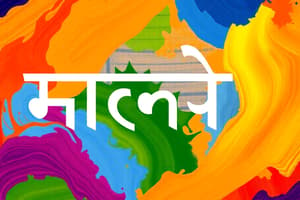Podcast
Questions and Answers
Which language is Hindi derived from?
Which language is Hindi derived from?
- Sanskrit (correct)
- Turkish
- Arabic
- English
Who spearheaded efforts to standardize Hindi?
Who spearheaded efforts to standardize Hindi?
- Indira Gandhi
- Bharatendu Harishchandra (correct)
- Mahatma Gandhi
- Jawaharlal Nehru
Which of the following states is part of the 'Hindi Belt'?
Which of the following states is part of the 'Hindi Belt'?
- West Bengal
- Uttar Pradesh (correct)
- Maharashtra
- Gujarat
What is the other official language of the Union government of India, besides Hindi?
What is the other official language of the Union government of India, besides Hindi?
Which of the following is a prominent dialect of Hindi?
Which of the following is a prominent dialect of Hindi?
Which script is used to write Hindi?
Which script is used to write Hindi?
What is the typical word order in Hindi grammar?
What is the typical word order in Hindi grammar?
Which language contributes a substantial part of the formal and technical vocabulary of Hindi?
Which language contributes a substantial part of the formal and technical vocabulary of Hindi?
Which empire's influence brought Persian and Arabic loanwords into Hindi?
Which empire's influence brought Persian and Arabic loanwords into Hindi?
From which language does Hindi derive much of its religious and philosophical vocabulary?
From which language does Hindi derive much of its religious and philosophical vocabulary?
Bollywood, the Hindi film industry, is based in which Indian city?
Bollywood, the Hindi film industry, is based in which Indian city?
Which script is used to write the Hindi language?
Which script is used to write the Hindi language?
What is the Hindi word for 'Thank you'?
What is the Hindi word for 'Thank you'?
Which of the following figures is a prominent writer of Hindi literature?
Which of the following figures is a prominent writer of Hindi literature?
In what fields has English primarily influenced Hindi vocabulary?
In what fields has English primarily influenced Hindi vocabulary?
What is the common grammatical base shared by Hindi and Urdu known as?
What is the common grammatical base shared by Hindi and Urdu known as?
Which movement significantly influenced the development of early Hindi literature?
Which movement significantly influenced the development of early Hindi literature?
What type of schools use Hindi as a medium of instruction and are run by the central government?
What type of schools use Hindi as a medium of instruction and are run by the central government?
Which of the following is a challenge faced by Hindi despite its widespread use?
Which of the following is a challenge faced by Hindi despite its widespread use?
In the context of computing, what ensures that Hindi text is displayed correctly across different platforms?
In the context of computing, what ensures that Hindi text is displayed correctly across different platforms?
What is a key difference between Hindi and Urdu in terms of script?
What is a key difference between Hindi and Urdu in terms of script?
What is the Hindi term for 'Hello' or 'Greetings'?
What is the Hindi term for 'Hello' or 'Greetings'?
Adopting new words for science and technology is part of what effort related to the Hindi language?
Adopting new words for science and technology is part of what effort related to the Hindi language?
Flashcards
Hindi
Hindi
An Indo-Aryan language spoken primarily in India; one of India's official languages.
Origin of Hindi
Origin of Hindi
Sanskrit and Prakrit.
Hindi Belt
Hindi Belt
States in northern and central India where Hindi is widely spoken.
Official Language of India
Official Language of India
Signup and view all the flashcards
Hindi Dialects
Hindi Dialects
Signup and view all the flashcards
Devanagari
Devanagari
Signup and view all the flashcards
Typical Hindi Word Order
Typical Hindi Word Order
Signup and view all the flashcards
Main source of formal Hindi vocabulary
Main source of formal Hindi vocabulary
Signup and view all the flashcards
Sanskrit's Influence
Sanskrit's Influence
Signup and view all the flashcards
Persian/Arabic Influence
Persian/Arabic Influence
Signup and view all the flashcards
English Influence
English Influence
Signup and view all the flashcards
Hindi Literature
Hindi Literature
Signup and view all the flashcards
Bollywood
Bollywood
Signup and view all the flashcards
Hindi in Media
Hindi in Media
Signup and view all the flashcards
Hindi in Education
Hindi in Education
Signup and view all the flashcards
Challenges for Hindi
Challenges for Hindi
Signup and view all the flashcards
Modernizing Hindi
Modernizing Hindi
Signup and view all the flashcards
Computer Usage
Computer Usage
Signup and view all the flashcards
Hindi & Urdu Relation
Hindi & Urdu Relation
Signup and view all the flashcards
Learning Hindi
Learning Hindi
Signup and view all the flashcards
नमस्ते (Namaste)
नमस्ते (Namaste)
Signup and view all the flashcards
Script Differences
Script Differences
Signup and view all the flashcards
Vocabulary Differences
Vocabulary Differences
Signup and view all the flashcards
Study Notes
- Hindi is an Indo-Aryan language spoken primarily in India.
- It is an official language of India, along with English.
- Hindi derives from Sanskrit and Prakrit.
- It is influenced by Dravidian, Turkish, Persian, Arabic, and English.
History
- Old Hindi evolved from Apabhramsa dialects between the 7th and 13th centuries.
- Modern Standard Hindi evolved in the 19th century.
- Standardization was promoted through the Devanagari script.
- Bharatendu Harishchandra spearheaded efforts to standardize Hindi.
- The British administration promoted Hindi.
- Hindi became a symbol of Indian identity.
Geographical Distribution
- Hindi is spoken across the "Hindi Belt," including:
- Uttar Pradesh
- Madhya Pradesh
- Bihar
- Haryana
- Rajasthan
- Himachal Pradesh
- Uttarakhand
- Delhi
- Significant Hindi-speaking populations exist in:
- Maharashtra
- West Bengal
- Gujarat
- Hindi is also spoken by the Indian diaspora worldwide.
Official Status
- Hindi is one of two official languages of India's Union government.
- English is the other official language.
- Article 343 of the Indian Constitution addresses official languages.
- Hindi is an official language of several Indian states.
Dialects
- Hindi features various dialects and regional variations.
- Prominent dialects include:
- Khariboli
- Braj Bhasha
- Awadhi
- Bagheli
- Bhojpuri
- Haryanvi
- Bundeli
- Marwari
- Chhattisgarhi
- Khariboli forms the base of Modern Standard Hindi.
- Dialects vary significantly in vocabulary and grammar.
Writing System
- Hindi is written in the Devanagari script.
- Devanagari is an abugida script.
- Characters represent consonants, with vowels indicated by diacritics.
- The script is written from left to right.
- It has about 44 characters, including vowels and consonants.
Grammar
- Hindi grammar is based on Sanskrit grammar.
- It is an analytic language.
- Nouns are inflected for gender (masculine and feminine), number (singular and plural), and case.
- Verbs are inflected for tense, aspect, mood, gender, and number.
- The typical word order is Subject-Object-Verb (SOV).
- Postpositions (similar to prepositions) are used.
Vocabulary
- Hindi vocabulary is influenced by several languages.
- Sanskrit contributes much of the formal and technical vocabulary.
- Persian and Arabic contribute common words, especially in everyday language.
- English influences Hindi vocabulary, particularly in modern and technical fields.
Influence of Sanskrit
- Sanskrit, India's classical language, has profoundly influenced Hindi.
- Many Hindi words are directly derived from Sanskrit.
- Sanskrit grammar and linguistic structures have shaped Hindi grammar.
- Religious, philosophical, and cultural vocabulary in Hindi comes from Sanskrit.
Influence of Persian and Arabic
- Persian and Arabic influence came through the Mughal Empire.
- Many Persian and Arabic loanwords are used in everyday Hindi.
- Examples include words related to administration, law, and culture.
- The influence is more pronounced in Urdu, which is mutually intelligible with Hindi but uses more Persian and Arabic vocabulary.
Influence of English
- English influence is a result of British colonial rule and globalization.
- Many English words have been adopted into Hindi, often with slight modifications.
- These loanwords are common in fields like technology, science, and business.
- The adoption of English words reflects the integration of Hindi into the global context.
Literature
- Hindi literature has a rich history spanning centuries.
- Early Hindi literature includes religious and devotional poetry.
- The Bhakti movement influenced the development of Hindi literature.
- Modern Hindi literature includes novels, short stories, poems, and plays.
- Prominent Hindi writers include:
- Premchand
- Jaishankar Prasad
- Mahadevi Varma
- Harivansh Rai Bachchan
- Nirmal Verma
- Hindi literature reflects social, political, and cultural changes in India.
Cinema
- The Hindi film industry, known as Bollywood, is based in Mumbai.
- Bollywood is one of the largest film industries globally.
- Hindi cinema has a wide audience both in India and abroad.
- Hindi films often feature music, dance, and drama.
- Bollywood films influence popular culture and fashion.
Media
- Hindi is widely used in Indian media, including:
- Newspapers
- Television channels
- Radio stations
- Online news portals
- Several Hindi-language newspapers have a large readership.
- Many television channels broadcast news, entertainment, and educational programs in Hindi.
- Hindi radio stations are popular in both urban and rural areas.
Education
- Hindi is taught as a compulsory subject in many schools across India.
- It is also offered as an optional subject in higher education.
- Central Hindi Directorate promotes the development and propagation of Hindi.
- Kendriya Vidyalaya Sangathan (KVS) schools, run by the central government, use Hindi as a medium of instruction.
Challenges
- Despite its widespread use, Hindi faces several challenges.
- One challenge is the promotion of Hindi in non-Hindi speaking regions of India.
- There is resistance to the imposition of Hindi as a national language.
- The preference for English in professional and educational settings also poses a challenge.
- Maintaining the purity of Hindi amidst the influence of English is another concern.
Modernization
- Efforts are being made to modernize Hindi to suit contemporary needs.
- This includes developing new vocabulary for science, technology, and other fields.
- Initiatives are underway to promote the use of Hindi on the internet and in digital media.
- Standardization of Hindi orthography and grammar helps in this regard.
Computer Usage
- Hindi is widely used on computers and mobile devices.
- Various Hindi keyboard layouts are available for typing in Devanagari.
- Unicode support ensures that Hindi text can be displayed correctly on different platforms.
- Many software applications and websites offer Hindi language support.
Relationship with Urdu
- Hindi and Urdu are mutually intelligible languages.
- They share a common grammatical base and core vocabulary, known as Hindustani.
- The primary difference between them is in the formal vocabulary.
- Hindi draws heavily on Sanskrit, while Urdu draws heavily on Persian and Arabic.
- Hindi is written in the Devanagari script, while Urdu is written in the Perso-Arabic script.
Learning Hindi
- Many resources are available for learning Hindi.
- These include textbooks, online courses, language learning apps, and immersion programs.
- Learning Hindi can provide insights into Indian culture and society.
- Proficiency in Hindi can open up opportunities in fields such as translation, journalism, and teaching.
Common Phrases
- नमस्ते (Namaste): Hello/Greetings
- आप कैसे हैं? (Aap kaise hain?): How are you?
- मैं ठीक हूँ (Main theek hoon): I am fine.
- धन्यवाद (Dhanyavaad): Thank you.
- आपका स्वागत है (Aapka swagat hai): You're welcome.
- मेरा नाम... है (Mera naam... hai): My name is...
- फिर मिलेंगे (Phir milenge): See you again.
Key Differences Between Hindi and Urdu
- Script: Hindi uses Devanagari, Urdu uses Perso-Arabic.
- Vocabulary: Hindi uses Sanskrit, Urdu uses Persian and Arabic.
- Origin: Both have roots in Khariboli, but evolved differently.
- Mutual Intelligibility: High at a colloquial level.
Studying That Suits You
Use AI to generate personalized quizzes and flashcards to suit your learning preferences.
Description
Exploration of the Hindi language. It covers its origins from Sanskrit and Prakrit, influences from other languages, and evolution through Old Hindi to Modern Standard Hindi. Focuses on its geographical distribution across the Hindi Belt and other parts of India.




